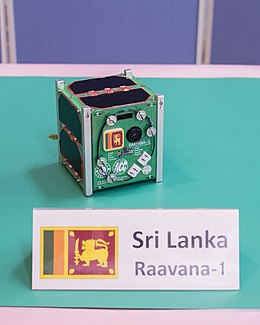Raavana 1
Raavana 1 is a Sri Lankan low orbit cube research satellite and the first satellite of Sri Lanka.[1][2] The satellite was launched as part of Cygnus NG-11 by the United States on 17 April 2019.[3] On 17 June 2019, the satellite was deployed into orbit after it was sent into space on 17 April 2019.
 | |
| Mission type | Space engineering |
|---|---|
| Operator | ACCIMT (Arthur C. Clarke Institute for Modern Technologies, Moratuwa, Sri Lanka) |
| COSPAR ID | 1998-067QB |
| Spacecraft properties | |
| Manufacturer | Kyushu Institute of Technology, Japan |
| Launch mass | 1.05kg |
| Start of mission | |
| Launch date | 17 April 2019 |
| Rocket | Cygnus NG-11 |
| Launch site | Virginia |
Development
The research satellite was developed by Tharindu Dayarathna and Dulani Chamika Vithanage, scholars of Peradeniya University's Engineering Faculty and Asian Institute of Technology.[1] The satellite was designed in Japan. It has a volume of about 1000 cubic centimetre and a mass of about 1.1 kg.[4] The lifespan of the satellite is about one and half years.[5]
The satellite will take images of Sri Lanka and other countries near Sri Lanka. It will use magnetic torquers to reduce its angular velocity.[5]
Origin of the name
When naming the country's first satellite, Sanath Panaavanna, Director General and Engineer at the Center for New Technology - Arthur C. Clark Institute of Sri Lanka, along with his two engineering students wanted to put forward an authentic name that represents Sri Lankan culture and history. Inevitably the name "Dadu Monara" ("දඬු මොණරය" in Sinhala) was a go-to choice. Dadu Monara is a flying device that appears in early Sri Lankan folklore and it is often accredited by historians to be the first aircraft ever created. However, due to the complexity of the word and the difficulty most non-native Sri Lankans would have with pronouncing this word, it was named after King Raavana ("රාවණ රජතුමා" in Sinhala), who ruled Sri Lanka at the time the Dadhu Monara was built. King Raavana is a notable King in Sri Lankan history with many contributions to ancient Sri Lanka.[6]
Launch
The satellite was handed over to Japan Aerospace Exploration Agency (JAXA) on 18 February, and the satellite was sent to International Space Station on 17 April at 2:16 a.m. Sri Lanka Standard Time, to be deployed from it later.[7][8] The satellite also was launched with Nepal's first satellite NepaliSat-1.[9] The satellite will orbit at an altitude of 400 kilometers, and the satellite contains five missions to complete.[10] Raavana 1 will be inside third batch known as BIRDS-3 together with satellites from Nepal and Japan.[11] Raavana 1 will take fifteen pictures per day.[12][13]
Mission
According to Nanosats database its missions is to "Provide ciphered short messages in its beacon in the 437 MHz band. Remote Data Collection based on low powered LoRa modulation for demonstration of remote data collection and processing onboard. Imaging mission for public outreach and awareness, Earth Magnetic Field measurement, Glue Mission: to find COTS alternative to expensive space glue and Active Attitude Stabilization as precursor to active pointing control for future CubeSat"[14]
Specifications
Section source[15]
- Country: Sri Lanka
- Type: CubeSat, 1U
- Organisation: Kyushu Institute of Technology
- Oneliner: Remote Data Collection based on low powered LoRa modulation for demonstration.
See also
References
- "Sri Lanka's "Raavana 1" successfully launched - Sri Lanka Latest News". Sri Lanka News - Newsfirst. 18 April 2019. Retrieved 18 April 2019.
- "IARU Sat Coordinator". www.amsatuk.me.uk. Retrieved 18 April 2019.
- "Nepal's first ever satellite launched into space". kathmandupost.ekantipur.com. Retrieved 18 April 2019.
- "Raavana 1 launched to ISS". www.dailymirror.lk. Retrieved 18 April 2019.
- admin (18 April 2019). "Sri Lanka's first satellite 'Raavana 1' launched". Colombo Gazette. Retrieved 18 April 2019.
- Tuesday Knowledge 1st |18-06-2019|Rupavahini, retrieved 7 August 2019
- "Sri Lanka : Sri Lanka\'s first satellite \'Raavana-1\' launched". www.colombopage.com. Retrieved 18 April 2019.
- Suneth (22 February 2019). "Raavana-1 satellite launch in April". Azimuth World. Retrieved 18 April 2019.
- JAYAWARDANA, Ruwini. "Sri Lanka's first satellite 'Raavana 1' launched today". Daily News. Retrieved 18 April 2019.
- Editorial (18 April 2019). "Sri Lanka's First Satellite, Raavana-1, Successfully Launched". Pulse. Retrieved 18 April 2019.
- "Bird B, BTN, G, J, JPN, LKA, M, MYS, N, NPL, PHL (BRAC Onnesha, Bhutan 1, GhanaSat 1, Toki, Uguisu, Raavana 1, Mazaalai, UiTMSAT 1, EduSat 1, NepaliSat 1, MAYA 1)". space.skyrocket.de. Retrieved 18 April 2019.
- "Raavana 1 satellite launched successfully". www.adaderana.lk. Retrieved 19 April 2019.
- "Raavana-1 to orbit earth 15 times a day - Sri Lanka Latest News". Sri Lanka News - Newsfirst. 18 April 2019. Retrieved 19 April 2019.
- "Database | nanosats.eu | Erik Kulu". Airtable. Retrieved 18 April 2019.
- Kulu, Erik. "Nanosatellite & CubeSat Database". Nanosatellite & CubeSat Database. Retrieved 18 April 2019.